Immerse yourself in the astonishing diversity of water birds in Alaska, where the wilderness is teeming with winged wonders. Nestled between pristine lakes, sweeping coastal shores, and vast wetlands, Alaska presents a captivating tableau of aquatic avian life.
From the swift flight of the Arctic Tern to the graceful paddling of the Sea Ducks, each species adds a unique hue to the Alaskan bird-watching palette. Join us as we dive into the world of these extraordinary feathered creatures and explore the splendor of Alaskan biodiversity.
Alaska Water Birds
In total there are over 80 species of waterbirds in Alaska, however we are just focusing on the 25 most common Alaska birds. There are several species of ducks, geese, puffins and both large birds and small birds in our list.
| Bird | Common Family Name | Best Time to Find in Alaska | Best Place in Alaska |
|---|---|---|---|
| Mallard | Ducks | Year-round | Wetlands, lakes, and ponds across Alaska |
| American Wigeon | Ducks | April-October | Coastal lagoons, lakes |
| Northern Pintail | Ducks | April-October | Coastal wetlands, marshes |
| Northern Shoveler | Ducks | April-October | Wetlands, shallow lakes |
| Blue-winged Teal | Ducks | May-September | Marshes, ponds |
| Green-winged Teal | Ducks | April-October | Wetlands, marshes |
| Bufflehead | Ducks | April-October | Coastal waters, lakes |
| Hooded Merganser | Ducks | May-September | Forested wetlands |
| Common Merganser | Ducks | Year-round | Freshwater lakes, rivers |
| Canada Goose | Geese | April-October | Lakes, ponds, coastal waters |
| Snow Goose | Geese | April-May and October-November | Coastal plains, wetlands |
| Tundra Swan | Swans | April-May and September-October | Wetlands, coastal waters |
| Great Blue Heron | Herons | April-October | Coastal waters, marshes |
| Common Loon | Loons | April-October | Large freshwater lakes, coastal waters |
| Double-crested Cormorant | Cormorants | April-October | Coastal cliffs, islands |
| Northern Fulmar | Fulmars | May-September | Offshore waters, cliffs |
| Arctic Tern | Terns | May-August | Coastal waters, wetlands |
| Common Murre | Auks | April-September | Offshore waters, rocky cliffs |
| Tufted Puffin | Puffins | April-August | Coastal cliffs, offshore islands |
| Short-tailed Shearwater | Shearwaters | May-October | Offshore waters |
| Glaucous-winged Gull | Gulls | Year-round | Coastal waters, landfills |
| Horned Puffin | Puffins | May-August | Coastal cliffs, offshore islands |
| Thick-billed Murre | Auks | April-September | Offshore waters, rocky cliffs |
| Parasitic Jaeger | Skuas and Jaegers | May-August | Tundra, coastal waters |
| Black-footed Albatross | Albatrosses | May-September | Offshore waters |
Water Bird Species Found in Alaska
American Wigeon
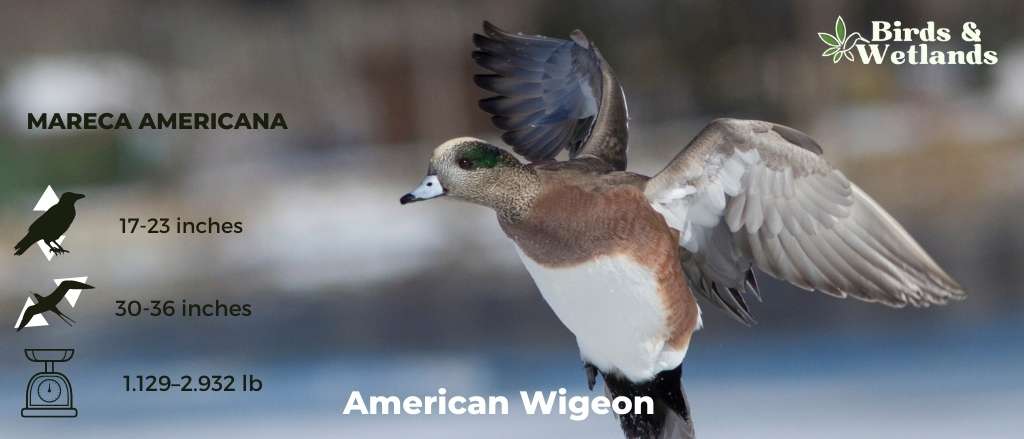
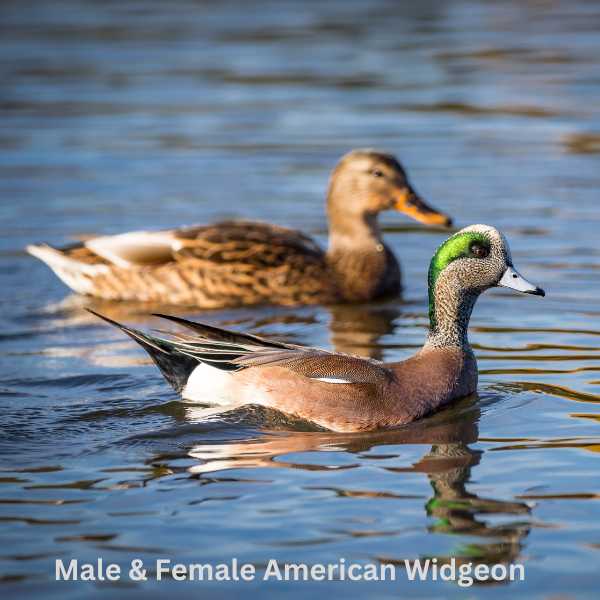
Listen to American Wigeon
Scientific Name: Mareca americana
Length: 17–23 in
Wingspan: 30–36 in
Weight: 1 –3 lb
The American Wigeon is a medium-sized duck species that is a popular sight in wetlands, ponds, and lakes and is often seen in mixed flocks with other ducks.
Males of the species are recognized by their distinctive appearance. They sport a unique white forehead and crown, coupled with a green band stretching from the eye to the back of the head. The body is mainly gray with a pinkish hue on the chest. Females are more subdued in color, with primarily gray and brown tones.
Diet: comprising mainly plant material like aquatic vegetation and grasses, but it also includes insects and other small invertebrates. They are known for a feeding behavior called “kleptoparasitism,” where they often snatch food from other ducks.
American Wigeons usually breed in the northernmost parts of North America. The females create their nests on the ground, often hidden in tall grass near water bodies. They lay a clutch of 6 to 11 eggs which they incubate for about three to four weeks and the ducklings feed on small aquatic invertebrates and aquatic insects.
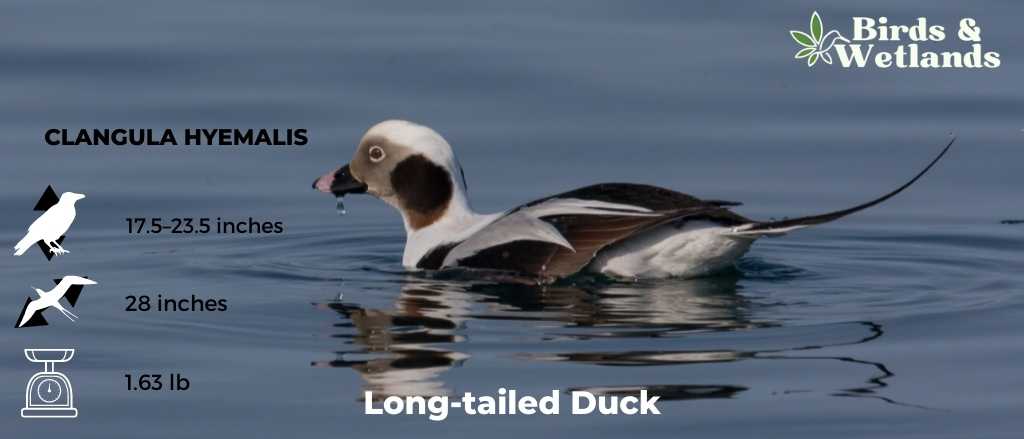

Listen
Scientific Name: Clangula hyemalis
Length: 17.5–23.5 in
Wingspan: 28 in
Weight: 1 –2 lb
The Long-tailed Duck is an intriguing sea duck, best recognized for its long, slender tail feathers and its unique, changing plumage.
Appearance: True to its name, the male Long-tailed Duck sports a pair of lengthy, slender tail feathers that trail behind him in flight. Their plumage changes with the season, transitioning between summer and winter. In winter, males exhibit a striking contrast of white with dark cheek patches, while the summer plumage features a dark chest and light-colored cheeks. Females have less distinctive plumage, primarily brown and grey.
Diet: The diet of Long-tailed Ducks mainly consists of small fish, crustaceans, and mollusks. They are extraordinary divers, able to dive deeper than most other duck species, sometimes up to 200 feet, to forage on the sea floor.
Reproduction: Long-tailed Ducks breed in the tundra of the far north, where they nest on the ground, often near water. The female lays a clutch of about six to eight eggs and is primarily responsible for incubation.
Northern Pintail

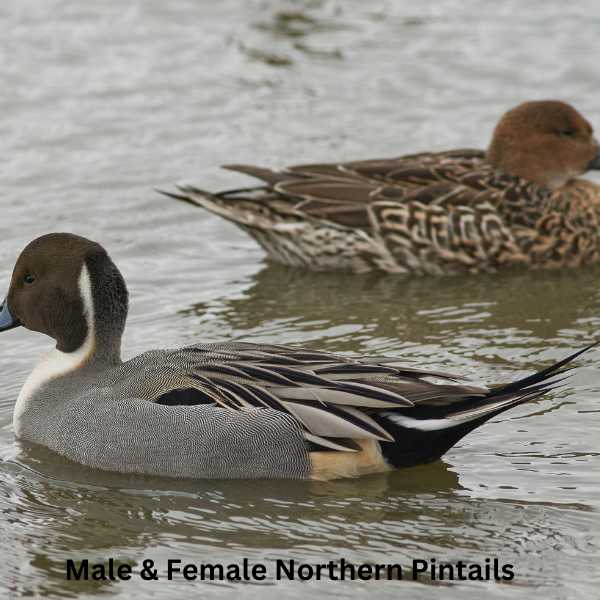
Listen to Northern Pintail
Scientific Name: Anas acuta
Length: 23–30 in
Wingspan: 31–37 in
Weight: 1 –3 lb
The Northern Pintail is a graceful species of duck recognized for their elegance in flight and their sleek bodies and long tails which is pin-shaped.
Male Northern Pintails are celebrated for their distinctive appearance, featuring a chocolate brown head, a white neck, and a grayish body. The most notable characteristic is the long, pointed tail feathers, which give this species its name. Females are more understated in color, sporting a mottled brown plumage.
Diet: Consists primarily of plant matter, including seeds and aquatic vegetation. They are also known to eat insects, especially during the breeding season. The Northern Pintail is often seen dabbling and upending in water bodies to forage for food.
Reproduction: Northern Pintails usually nest on the ground, near water bodies. The female lays a clutch of 7 to 9 eggs and is solely responsible for their incubation, which lasts for about three weeks.
Northern Shoveler

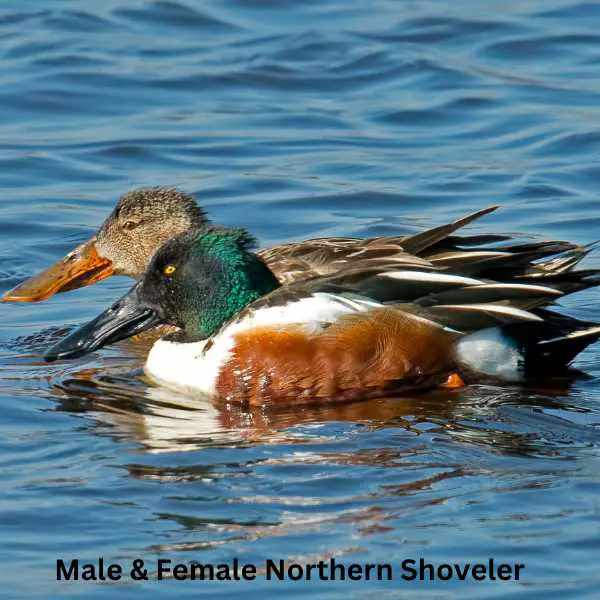
Listen to Northern Shoveler
Scientific Name: Spatula clypeata
Length: 16 in
Wingspan: 22 in
Weight: 14 oz
The Northern Shoveler is a distinct species of dabbling duck celebrated for its long, spoon-shaped bill, a feature that sets it apart from other ducks and gives the bird its name.
Appearance: Male Northern Shovelers are particularly striking, boasting a green head, yellow eyes, a large black bill, and a white chest, complemented by a chestnut-colored body. Females, on the other hand, feature a more muted color scheme, primarily displaying mottled brown feathers across their bodies and a slate-gray bill.
Diet: The Northern Shoveler’s unique bill is perfectly adapted for its feeding habits. The edges of the bill are furnished with comb-like structures that enable the bird to filter food from water. Their diet predominantly consists of aquatic invertebrates and plant matter, including seeds and algae.
Reproduction: Northern Shovelers typically nest on the ground, concealed within dense, grassy areas close to water bodies. The female lays a clutch of about 9 to 12 eggs and is solely responsible for their incubation, which lasts for about three to four weeks.
Blue-winged Teal
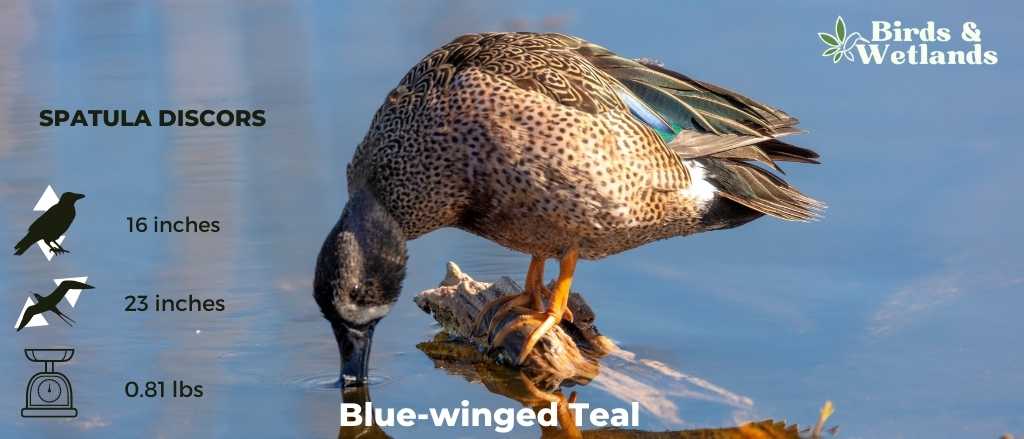

Listen to Blue-winged Teal
Scientific Name: Spatula discors
Length: 16 in
Wingspan: 23 in
Weight: 13 oz
The Blue-winged Teal is a small species of dabbling duck known for its striking plumage and its extensive migratory habits.
Appearance: Male Blue-winged Teals are quite colorful, with a slate gray head and neck, a white crescent in front of the eyes, and a predominantly brown body with specks of black. The name “Blue-winged” comes from the patch of blue feathers visible on their wings during flight. Females, in contrast, are primarily brown and subtly mottled to provide camouflage.
Diet: The Blue-winged Teal feeds mainly on plant matter, such as seeds and aquatic vegetation. However, they also supplement their diet with small invertebrates, especially during the breeding season. They are known for their “dabbling” behavior, where they feed at the surface of the water rather than diving.
Reproduction: Blue-winged Teals prefer to nest on the ground in grassy areas near water. The female typically lays a clutch of 9 to 13 eggs, which she incubates alone for about three weeks. After hatching, the ducklings can feed themselves but remain under the mother’s protection until they are capable of flying.
Bufflehead


Listen to Bufflehead
Scientific Name: Bucephala albeola
Length: 13–16 in
Wingspan: 21.6 in -23.2 in
Weight: 9.5–19.4 oz
The Bufflehead is a small, compact species of diving duck known for its striking appearance and large heads and unique nesting habits.
Appearance: Male Buffleheads are easily recognized by their large, bulbous head with a green-purple iridescent sheen, a large white patch across the back of the head, and a predominantly black and white body. Females are more subtly colored, primarily in gray-brown tones with a smaller white cheek patch.
Diet: As diving ducks, Buffleheads feed by diving beneath the water’s surface. Their diet consists largely of aquatic invertebrates, such as insects, crustaceans, and mollusks, as well as some plant matter.
Reproduction: Uniquely among ducks, Buffleheads often nest in tree cavities, especially those made by Northern Flickers, a type of woodpecker. The female lays a clutch of about 6 to 11 eggs, which she incubates alone for roughly a month.
Hooded Merganser

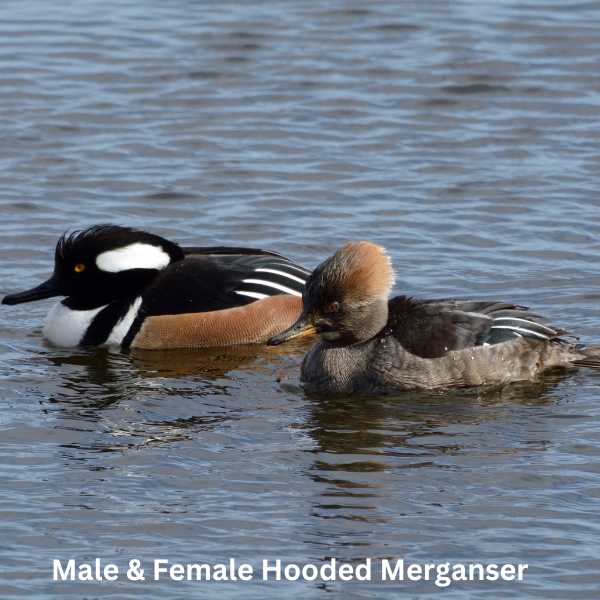
Listen to Hooded Merganser
Scientific Name: Lophodytes cucullatus
Length: 15.8-19.3 in
Wingspan: 23.6-26.0 in
Weight: 16.0-31.0 oz
The Hooded Merganser is a distinctive species of diving duck known for its showy crest and its excellent diving skills.
Appearance: Male Hooded Mergansers are especially striking with a large, fan-shaped, black and white crest, which can be expanded or contracted. They have bright yellow eyes, a dark back, and a white chest. The females have a more understated appearance with a brownish body, a smaller, reddish-brown crest, and dark eyes.
Diet: Consists of small fish, aquatic insects, and crustaceans. Their eyes are specially adapted for underwater vision, allowing them to spot and catch prey while diving.
Reproduction: Similar to Buffleheads, Hooded Mergansers often nest in tree cavities near water bodies. The female lays a clutch of about 10 to 12 eggs and incubates them alone for about a month.
Canada Goose


Canada Goose Sound
Scientific Name: Branta canadensis
Length: 30 to 43 in
Wingspan: 50–73 in
Weight: 5.7–14.3 lb
The Canada Goose is a large, well-known species of waterfowl noted for its distinctive appearance, familiar “honk,” and migratory behavior.
Appearance: Both male and female Canada Geese have a similar appearance, featuring a black head and neck with distinctive white patches on the cheeks and chin. The body is primarily brown with a lighter, often white, underbelly.
Diet: Canada Geese primarily feed on plant matter, including grasses, aquatic vegetation, and grains. They can often be seen grazing in parks, lawns, and fields, as well as dabbling in water bodies.
Reproduction: Canada Geese typically nest on the ground near water bodies, often on islands or other isolated areas to avoid predators. The female lays a clutch of about 4 to 6 eggs, which she incubates alone for around a month.
Snow Goose

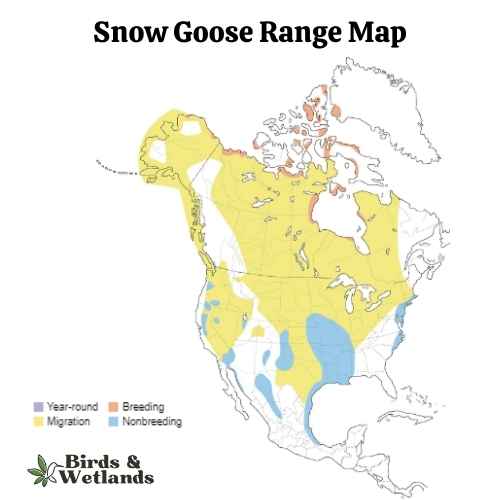
Snow Goose Sound
Scientific Name: Anser caerulescens
Length: 25 to 31 in
Wingspan: 53 to 65 in
Weight: 4.5 to 6.0
The Snow Goose is a large species of waterfowl known for its vibrant white plumage and significant migratory flights.
Appearance: True to their name, Snow Geese are predominantly white with black wingtips. They also have a pink bill, pink legs and feet. A color morph, known as the “Blue Goose,” displays a bluish-gray body with a white head, but is considered the same species.
Diet: Snow Geese primarily feed on plant matter, such as grasses, sedges, and small grains. They can often be seen in large flocks foraging in fields and marshes, and during migration and winter, they can cause considerable damage to agricultural fields due to their feeding habits.
Reproduction: Snow Geese typically nest on the tundra, near water bodies. The female builds the nest and lays a clutch of about 3 to 5 eggs, which she incubates alone for approximately three weeks. Once hatched, the goslings can feed themselves but stay with their parents for protection until they can fly.
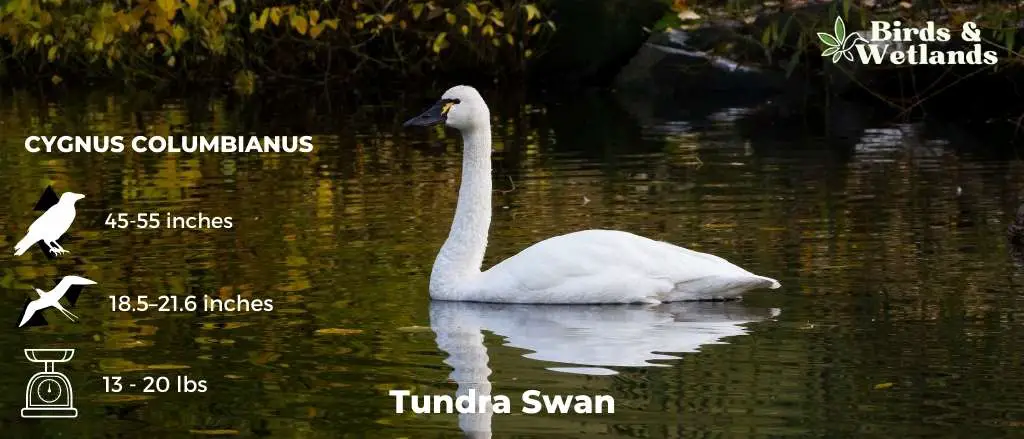
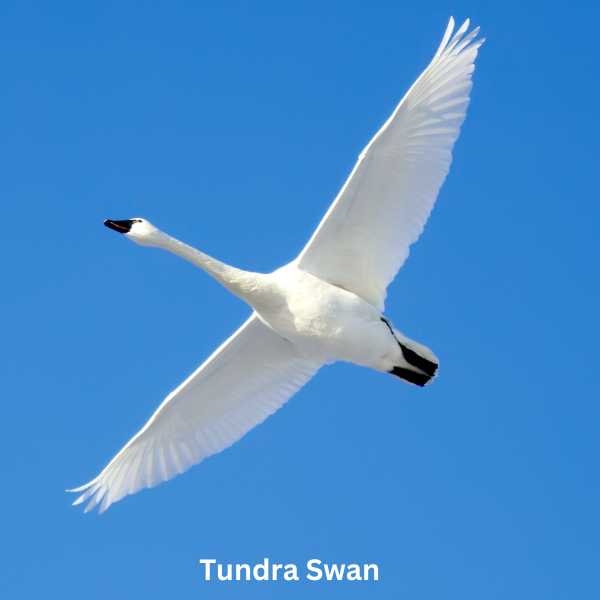
Listen to Tundra Swan
Scientific Name: Cygnus columbianus
Length: 45–55 in
Wingspan: 18.5–21.6 in
Weight: 13 – 20 pounds
The Tundra Swan is a large, graceful species of waterfowl known for its elegant appearance, long migratory journeys, and melodic calls.
Appearance: Tundra Swans, as the name suggests, are predominantly white, which aids in camouflage against the snowy landscapes of their breeding grounds. They have a long neck, a black bill, and black feet. One of the distinguishing characteristics of Tundra Swans is a small yellow spot near the eye, which can vary among individuals.
Diet: Tundra Swans primarily feed on plant matter, including aquatic vegetation, roots, tubers, and grains. They forage by dipping their long necks under the water in shallow areas, or by upending in deeper waters.
Reproduction: Tundra Swans breed in the high Arctic tundra, near ponds and lakes. The female builds the nest and lays a clutch of about 3 to 5 eggs, which she incubates alone for roughly a month.
Great Blue Heron


| Feature | Measurement |
|---|---|
| Scientific Name | Ardea herodias |
| Length | 36–54 in |
| Wingspan | 66–79 in |
| Weight | 1.82–3.6 kgs |
Great Blue Herons are the largest heron species in North America, is distinguished by its tall stature and unique blue-gray plumage.
Measuring up to 4.5 feet tall with a wingspan of approximately 6.5 feet, the bird features a long, pointed bill, a white head with a black eye stripe extending to slender black plumes, and robust, elongated legs. Its distinctive flight pattern, forming a tight “S” shape with its neck, sets it apart from similar large birds, like cranes.
Inhabiting various wetland habitats, including marshes, lakes, rivers, and coastal regions throughout much of North and Central America, the Great Blue Heron is a wading bird. Often seen poised statue-like at the water’s edge, these birds are expert hunters, spearing fish and capturing small animals with their sharp bills.
Arctic Loon (Gavia arctica)


Listen to Artic Loons
Scientific Name: Gavia arctica
Length:23 to 29 in
Wingspan: 39 – 51 in
Weight: 2.9–7.5 lb
The Arctic Loon is a captivating species of waterbird noted for its elegant appearance, skilled diving capabilities, and far northern habitat.
Appearance: Arctic Loons are medium-sized birds with a streamlined body, sharp beak, and a distinctive black-and-white checkered back during breeding season. The head and neck are gray to black, and they display a striking greenish or purplish sheen, depending on the light. In winter, their plumage is more subdued, with the upperparts gray and the underparts white.
Diet: Arctic Loons are excellent divers and primarily feed on a diet of fish and invertebrates, such as crustaceans and mollusks. They dive beneath the water’s surface, often for a minute or more at a time, to catch their prey.
Reproduction: Arctic Loons breed in the tundra regions near freshwater lakes and ponds. The female typically lays two eggs, which both parents incubate. Within a couple of days after hatching, the young chicks can swim and often ride on the backs of their parents.
Double-crested cormorant


| Feature | Measurement |
|---|---|
| Scientific Name | Nannopterum auritum |
| Length | 28–35 in |
| Wingspan | 45–48 in |
| Weight | 1.2–2.5 kg |
The Double-Crested Cormorant (Phalacrocorax auritus) is a large waterbird known for its long neck, hooked bill, and almost entirely black body. The species gets its name from the two small patches of tufted feathers or “crests” found on the heads of breeding adults, one on each side. These birds are strong swimmers that propel themselves underwater with their webbed feet, their bodies submerged and necks above the water surface, giving them a characteristic snake-like appearance when swimming.
Double-Crested Cormorants are widely distributed across North America and can be found in a variety of aquatic environments including freshwater lakes, coastal areas, and rivers. Their diet primarily consists of fish, which they catch by diving from the water’s surface. Often seen perched with wings outstretched to dry after fishing, these cormorants nest in trees, on the ground, or on cliff edges, usually in colonies. While they have rebounded from decreases in the mid-20th century due to DDT-related reproductive failures, they face ongoing threats from habitat loss, entanglement in fishing gear, and conflicts with fisheries over their consumption of fish. Protection and careful management of their habitats are key to their ongoing conservation.
Northern Fulmar (Fulmarus glacialis)


Listen to Northern Fulmar
Scientific Name: Fulmarus glacialis
Length: 18 in
Wingspan: 40 – 44 in
Weight: 16 – 35 oz
The Northern Fulmar is a sturdy seabird recognized for its robust body, tubed nostrils, and impressive gliding flights.
Appearance: Northern Fulmars are medium-sized birds with a robust body, a thick neck, and a strong, short bill. They come in two main color morphs: a light one, where birds are primarily white with a grayish back and wings, and a dark one, where birds are uniformly gray. Their bill is yellow with a distinctive tubed nostril structure on top, an adaptation shared by all birds in the Procellariiformes order.
Diet: Northern Fulmars are excellent foragers and their diet primarily consists of small fish, squid, and marine zooplankton. They often feed by picking up prey from the water’s surface while in flight or while swimming.
Reproduction: Northern Fulmars nest on cliff ledges in large colonies. The female lays a single egg, which both parents incubate for about seven weeks.
Arctic Tern (Sterna paradisaea)


Listen to Artic Term
Scientific Name: Sterna paradisaea
Length: 11 – 15 in
Wingspan: 26 – 30 in
Weight: 3.5-4.5 oz
The Arctic Tern is an extraordinary seabird known for its astonishing long-distance migratory flights, making it one of the farthest traveling species on the planet. Each year, these birds journey from their Arctic breeding grounds to the Antarctic and back, a round trip of over 24,000 miles, experiencing two summers and more daylight than any other creature on Earth.
Appearance: Arctic Terns are medium-sized birds with a slender body, a long, pointed bill, and a deeply forked tail. They display a bright white underbody, a pale gray back and wings, and a black cap on the head. During the breeding season, their bill turns a vibrant red.
Diet: Arctic Terns primarily feed on a diet of small fish and invertebrates. They often catch their prey by performing a swift, plunging dive into the water from flight.
Reproduction: Arctic Terns breed in open, tundra-like habitats or on rocky islands. The female typically lays one to three eggs, and both parents share the incubation duties.
Common Murre (Uria aalge)

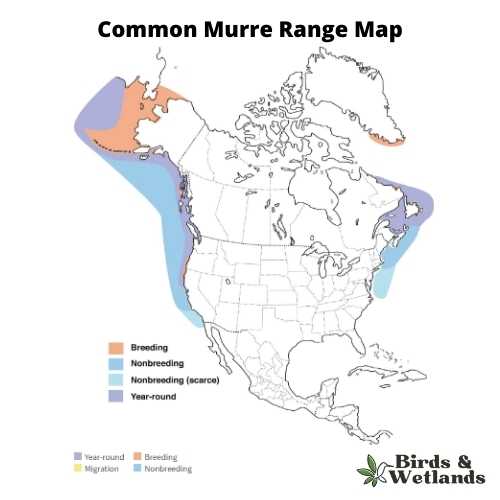
Listen
Scientific Name: Uria aalge
Length: 15 – 18 in
Wingspan: 24 – 29 in
Weight: 1.5-2.4 lbs
The Common Murre is a large seabird known for its streamlined body, fast flight, and cliffside nesting habits.
Appearance: Common Murres have a sleek, penguin-like shape with a dark back and wings, and a white underside. They have a thin, pointed bill and during the breeding season, they sport a black face and throat. In the non-breeding season, their face and throat become white.
Diet: Common Murres primarily feed on fish and invertebrates. They are exceptional divers and can plunge below the sea surface from the air or while swimming to catch their prey. Their dives can be remarkably deep, reaching up to 100 meters or more.
Reproduction: Common Murres breed in large colonies on cliff ledges, where the female lays a single, pointed egg directly on the bare rock. Both parents share incubation duties and care for the chick once it hatches. Interestingly, the egg is uniquely shaped to prevent it from rolling off the cliff.
Tufted Puffin (Fratercula cirrhata)
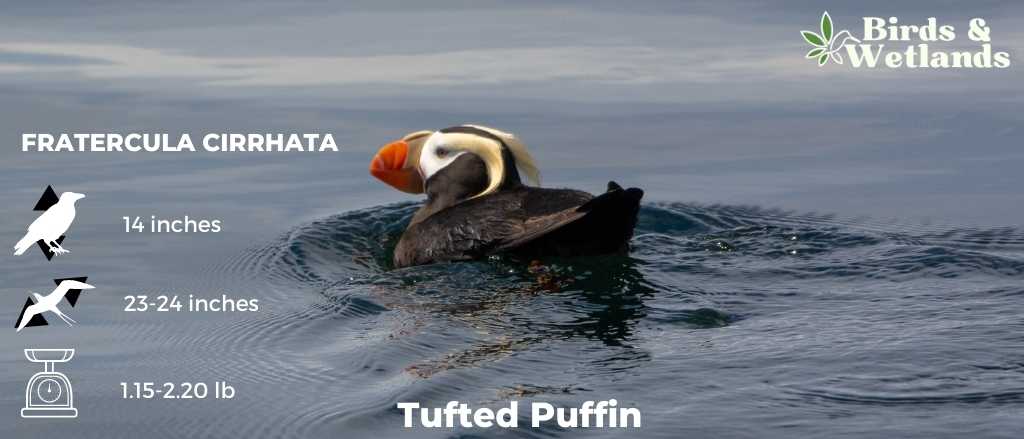
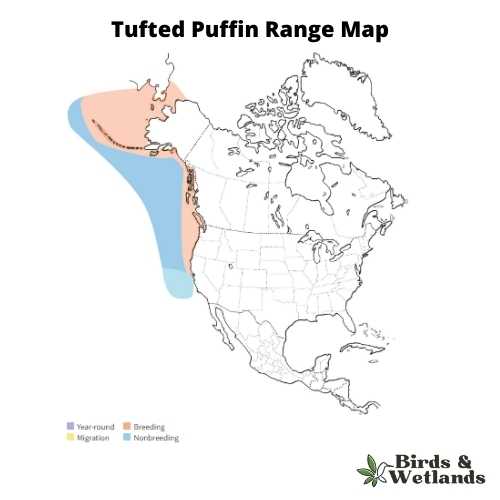
Listen
Scientific Name: Fratercula cirrhata
Length: 13 – 15 in
Wingspan: 23 – 24 in
Weight: 18.4 to 35.3 oz
The Tufted Puffin is a charismatic seabird recognized for its striking appearance, exceptional swimming skills, and distinct nesting habits.
Appearance: Tufted Puffins are medium-sized birds characterized by their black body, large orange bill, and white face. What makes them truly stand out are the long, yellow tufts that curve backward from each side of their head during the breeding season, giving them their name.
Diet: Tufted Puffins primarily feed on a diet of small fish and invertebrates. They are excellent divers and can plunge into the sea from flight to catch their prey. When foraging for their chicks, they are known to carry multiple fish crosswise in their bills.
Reproduction: Tufted Puffins breed in large colonies on cliff tops or slopes. They nest in burrows, which the female digs with her bill and feet. The female lays a single egg, and both parents share the incubation duties.
The Short-tailed Shearwater (Ardenna tenuirostris)


Listen
Scientific Name: Ardenna tenuirostris
Length: 15 – 16 in
Wingspan: 18 – 22 in
Weight: 18.4 to 35.3 oz
The Short-tailed Shearwater is a medium-sized seabird recognized for its proficient gliding skills, migratory habits, and characteristic short tail. Every year, these birds embark on a long journey from their breeding grounds in Australia to the Bering Sea near Alaska, a round trip of approximately 15,000 miles.
Appearance: Short-tailed Shearwaters have a streamlined body with a dark brown to sooty coloration overall. Their name derives from their relatively short, rounded tail. They have a thin, pointed bill which is adapted for their feeding style.
Diet: Short-tailed Shearwaters primarily feed on small fish, squid, and krill. They are excellent divers and can dive up to 70 meters deep into the ocean to catch their prey. They often feed while on long flights by swooping down to the water’s surface and catching prey with their bill.
Reproduction: Short-tailed Shearwaters breed in large colonies on sandy islands, laying a single egg in a burrow dug into the ground.
Glaucous-winged Gull (Larus glaucescens)


Listen
Scientific Name: Larus glaucescens
Length: 20 – 27 in
Wingspan: 47 – 59 in
Weight: 1.61–3.73 lb
The Glaucous-winged Gull is a large, adaptable seabird known for its broad range, resilience, and characteristic wing coloration.
Appearance: As the name implies, Glaucous-winged Gulls possess ‘glaucous’ or light gray coloration on their wings, matching the color of their body. They have a sturdy build, with a heavy bill and a rounded head. In adult birds, the bill is yellow with a red spot near the tip, and the legs are pink.
Diet: Glaucous-winged Gulls are opportunistic feeders with a diet that primarily includes fish, invertebrates, carrion, and human food waste. They often scavenge along shorelines, in harbors, and around human habitation, making them a common sight in coastal cities and towns.
Reproduction: These gulls nest in colonies on the ground, cliffs, or in low trees. The female typically lays two to three eggs in a nest built from grass, seaweed, and other plant materials.
Horned Puffin (Fratercula corniculata)
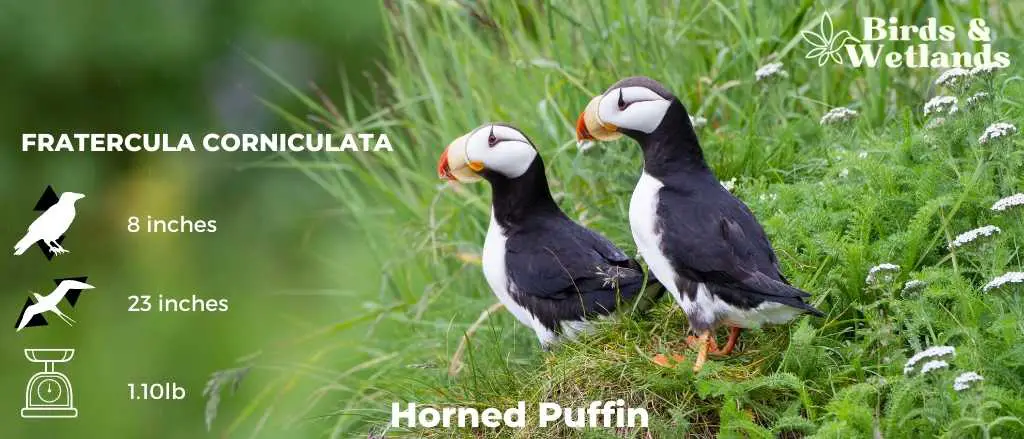

Listen
Scientific Name: Fratercula corniculata
Length: 8 in
Wingspan: 23 in
Weight: 18oz
The Horned Puffin is a distinctive seabird known for its bold facial markings, powerful swimming skills, and unique nesting practices. Horned Puffins are an emblematic sight along the coasts of the North Pacific Ocean, particularly in Alaska and Siberia.
Appearance: Horned Puffins get their name from the small, fleshy black ‘horn’ above each eye. They have a large, orange, parrot-like bill, which becomes brightly colored during the breeding season. Their body is black on the back and white on the belly. These birds also have a small but noticeable white ‘eyebrow’ and a dark eye-line extending towards the back of the head, giving them a striking appearance.
Diet: Horned Puffins primarily feed on small fish and, to a lesser extent, invertebrates. They are excellent divers and catch their prey by diving from the surface of the water and swimming using their wings for propulsion.
Reproduction: Horned Puffins breed in colonies on cliff faces or rocky islands. They nest in crevices or burrows where the female lays a single egg.
Parasitic Jaeger (Stercorarius parasiticus)

Length: 8 in

Listen
Scientific Name: Stercorarius parasiticus
Length: 16 – 19 in
Wingspan: 42 – 49 in
Weight: 11oz – 21oz
The Parasitic Jaeger, also known as the Arctic Skua, is a robust seabird renowned for its predatory and kleptoparasitic behavior, meaning it often steals food from other birds.
Appearance: Parasitic Jaegers have a variable coloration that ranges from dark brown to a combination of chocolate brown and cream. They feature pointed wings and a slightly rounded tail with projecting central feathers. During the breeding season, adults sport a distinctive patch of yellow or creamy color at the side of the neck.
Diet: The diet of Parasitic Jaegers primarily consists of small mammals, birds, fish, and insects. However, they’re best known for their strategy of relentlessly pursuing other birds in flight until the distressed prey drops or regurgitates their food, which the jaeger then catches and eats – a behavior known as kleptoparasitism.
Reproduction: Parasitic Jaegers breed in the Arctic tundra, where they nest on the open ground. The female typically lays one to three eggs.
Black-footed Albatross (Phoebastria nigripes)


Listen
Scientific Name: Phoebastria nigripes
Length: 27 – 29 in
Wingspan: 6.2–7.2 ft
Weight: 5.7–9.5 lb
The Black-footed Albatross is a large seabird known for its exceptional flying and foraging skills, as well as its long-distance oceanic travels. They are capable of flying thousands of miles across the ocean to forage for food while expending very little energy, a trait known as dynamic soaring.
Appearance: Black-footed Albatrosses are notable for their overall dark plumage, which is brownish-black, contrasting with a white patch around the base of the bill and behind the eye. As their name suggests, they have dark feet. Their bill is large, pinkish, and hooked, well adapted for catching prey.
Diet: These albatrosses primarily feed on squid, but also eat fish and other marine invertebrates. They are known to follow ships to pick up scraps and are proficient divers, able to plunge into the ocean to capture their prey.
Reproduction: Black-footed Albatrosses nest on remote islands in the North Pacific Ocean, laying a single egg in a ground nest made of sand and vegetation.
Where to Spot Alaska’s Water Birds
Yukon Delta National Wildlife Refuge: This is one of the largest refuges in the U.S., providing nesting grounds for a huge variety of water birds. The Delta is particularly well-known for the Emperor Goose and Spectacled Eider.
Potter Marsh Bird Sanctuary: Nestled in the Anchorage Coastal Wildlife Refuge, this site offers a boardwalk for easy viewing of its many water bird residents, like Mallards and Northern Pintails.
Alaska Maritime National Wildlife Refuge: Sprawled across 2,500 islands, rocks, and reefs, this refuge hosts a wide array of water birds, including the rare Short-tailed Albatross and Tufted Puffins.
Creamer’s Field Migratory Waterfowl Refuge: Located in Fairbanks, it’s a crucial resting spot for migrating water birds, offering sightings of the beautiful American Wigeon and Green-winged Teal.
Kachemak Bay State Park: Known for its diverse ecosystem, this park in Homer, Alaska is an excellent location to observe Glaucous-winged Gulls and Common Loons.
Neighboring States to Alaska and their Main Water Bird-Watching Sites:
| State | Main Water Bird-Watching Site |
|---|---|
| Washington Water Birds | Nisqually National Wildlife Refuge |
| Oregon Water Birds | Malheur National Wildlife Refuge |
| Idaho Water Bird Species | Deer Flat National Wildlife Refuge |
| Montana Water Birds | Lee Metcalf National Wildlife Refuge |
Tips on How to Spot Water Birds in Alaska?
Time of Year: The best time to spot water birds in Alaska is during the spring and fall migration seasons. Many birds travel through Alaska during these times, so you’ll have a high chance of seeing a variety of species.
Visit Known Birding Hotspots: Locations such as the Yukon Delta National Wildlife Refuge, Potter Marsh Bird Sanctuary, and Alaska Maritime National Wildlife Refuge are renowned for their water bird populations. Plan a trip to these areas for high-quality bird watching.
Arrive Early or Stay Late: Birds are often most active during the early morning and late afternoon. Arriving at these times can increase your chances of spotting water birds.
Quiet and Patience: Birds can be easily scared away by loud noises. Move slowly and quietly, and be patient. Some birds might take a while to appear.
Use a Good Pair of Binoculars: Water birds often stay on the far side of lakes or in the middle of rivers. A pair of high-quality binoculars can help you spot and identify them from a distance.
Learn Bird Calls: Many birds are easier to hear than to see. By learning the calls of different water birds, you can identify them even if they’re hidden.
Dress Appropriately: Alaska’s weather can change rapidly, especially in and around water bodies. Wear layers and waterproof clothing to ensure you’re comfortable during your bird watching expedition.
Keep a Field Guide Handy: A good field guide can help you identify different species and understand their behaviors, enhancing your bird watching experience.
Remember, bird watching is as much about enjoyment and connecting with nature as it is about spotting and identifying different species. Take your time, and savor the experience.
The state bird of Alaska is not a water bird. Other water birds include:
- Calidris pusilla: Semipalmated Sandpiper
- Calidris mauri: Western Sandpiper
- Calidris virgata: Surfbird
- Calidris alpina: Dunlin
- Calidris minutilla: Least Sandpiper
- Calidris melanotos: Pectoral Sandpiper
- Calidris himantopus: Stilt Sandpiper
- Calidris bairdii: Baird’s Sandpiper
- Common eider
- common merganser

